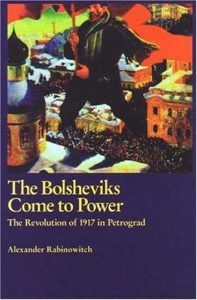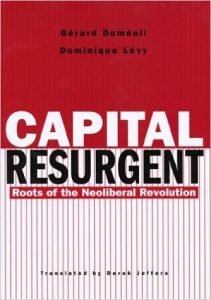Book Reviews: ‘The Bolsheviks Come to Power’, ‘Capital Resurgent’, & ‘Rehearsals for Change’
Bolsheviks as history
‘The Bolsheviks Come to Power: The Revolution in Petrograd’. By Alexander Rabinowitch. Pluto Press. £12.99
 When this book was first published in 1976 it had some contemporary significance. The regime established by the Bolsheviks in November 1917 was still extant and many young people, dissatisfied with capitalism, were discussing Bolshevik tactics and forms of organisation as a serious way to overthrow it. Today, republished nearly thirty years later, it is a work of history much as would be a study of Robespierre and the Jacobins in 1793.
When this book was first published in 1976 it had some contemporary significance. The regime established by the Bolsheviks in November 1917 was still extant and many young people, dissatisfied with capitalism, were discussing Bolshevik tactics and forms of organisation as a serious way to overthrow it. Today, republished nearly thirty years later, it is a work of history much as would be a study of Robespierre and the Jacobins in 1793.
Studying history is not a waste of time of course and Rabinowitch’s research does bring out some interesting points, in particular that the Bolshevik Party in 1917 was not a monolithic bloc under Lenin’s thumb. He shows how in fact Lenin’s views were often ignored by other Bolshevik leaders in closer touch with the feelings of soldiers and factory workers in Petrograd (as St. Petersburg was then called). It also emerges that Stalin played a rather more significant role than Trotskyists attribute him in their polemics.
Lenin favoured a naked seizure of power by the Bolshevik Party; most of the other Bolshevik leaders were more circumspect; they realised, as Rabinowitch documents, that while most of the workers and soldiers wanted “peace, land and bread” and, by November 1917, were in favour of the overthrow of the Provisional Government under Kerensky because it sought to continue the war, they wanted to see it replaced by a government made up of all the “socialist” parties of Russia, i.e. of the Mensheviks and Social-Revolutionaries as well as the Bolsheviks, that would emanate from the Congress of Soviets and which would take Russia out of the war. The Bolsheviks, therefore, followed the more subtle approach of disguising the seizure of power advocated (sometimes hysterically) by Lenin as an assumption of power by the Congress of Soviets.
Thus the Bolshevik seizure of power in November 1917 looked to be a “Soviet” revolution, with power appearing to pass into the hands of these makeshift representative institutions (the Russian word “soviet” means simply “council”) that soldiers and workers had formed to give expression to their political views. In fact, power had passed into the hands of the minority Bolshevik Party which was determined to hold on to it, alone, come what may. But that’s another (hi)story.
ALB
************************************************************
Ups and Downs
‘Capital Resurgent – Roots of the Neoliberal Revolution’. By Gérard Dumenil and Dominique Lévy. Harvard University Press. £35.95.
 The first parts of this book are filled with graphs and tables which deal with categories Marxists can recognise, such as the rate of profit, the rate of capital accumulation, and the share of wages and of profits in value added. Dumenil and Lévy argue that what drives the capitalist economy is the rate of profit and that this had begun to fall even in the 1960s. They explain this by the slow-down in the technological progress of the previous two decades which had provided an expanding market for producer goods and so had driven the whole economy forward; this resulted in a fall in the rate of capital accumulation and consequently in the high level of unemployment that was a feature of the 1970s and 1980s. This is one possible Marxian explanation.
The first parts of this book are filled with graphs and tables which deal with categories Marxists can recognise, such as the rate of profit, the rate of capital accumulation, and the share of wages and of profits in value added. Dumenil and Lévy argue that what drives the capitalist economy is the rate of profit and that this had begun to fall even in the 1960s. They explain this by the slow-down in the technological progress of the previous two decades which had provided an expanding market for producer goods and so had driven the whole economy forward; this resulted in a fall in the rate of capital accumulation and consequently in the high level of unemployment that was a feature of the 1970s and 1980s. This is one possible Marxian explanation.
But then the approach changes. In the 1970s double-digit inflation benefited industrial capital at the expense of finance capital as loans could be repaid in depreciated money. According to Dumenil and Lévy, finance capital fought back by staging what they call a “coup” on 1979 – a sudden rise in interest rates as a way of trying to stop inflation. This put the boot on the other foot with, again according to the authors, firms having to use their profits to repay loans rather than re-investing them, so penalising growth and sustaining unemployment. This marked the beginning, they say, of the current period of “neoliberalism”, of deregulation and return to “free market” economics, as practised by Reagan in America and Thatcher in Britain.
Dumenil and Lévy see this as a deliberate policy choice, imposed by finance capital and its representatives in government rather than any government’s reaction to a particular set of capitalist conditions. Their position can be summed up as “another policy is possible” (rather less ambitious than “another world is possible”, but a more accurate reflection of what the movement whose slogan this is actually stands for). This other policy turns out to be the sort of monetary, financial and tax measures favoured, and applied in the 1950s and 60s, by the Keynesians which, according to the authors, worked acceptably enough, as far as this sort of thing is possible under capitalism, until the rate of profit dropped for other reasons and finance capital staged its coup.
A rather odd conclusion for writers claiming to be in the Marxist tradition, but even odder is their analysis of the 1929 crash and 1930s slump in purely monetary and financial terms, even suggesting that these could have been avoided if the right policies had been pursued.
ALB
************************************************************
Settling for what you don’t want
‘Rehearsals for Change: Politics and Culture in Australia’. By Dennis Altman. Perth, Australian Public Intellectual Network, 2004
It looks encouraging that the index to this book has about 20 references both to socialism and Marxism. Unfortunately from a socialist point of view, this is deceptive.
The author sees himself as an actor in rehearsals for change, but when it comes to the performance itself he proves to be no revolutionary. His subject is politics and culture in contemporary Australia. Like the “vote Labour with no illusions” brigade in Britain, he believes that “a Labor government will probably disappoint those of us who want radical change, but it will be more susceptible to pressures from the left than is a conservative government.” So for the author it’s the old choice between the lesser of two evils. Don’t go for what you really want — settle for the least unpalatable version of what you don’t want.
Altman knows “There are strong pressures on the ALP (Australian Labor Party) to accept the need to cut back on its aspirations and become an alternative manager of recession.” Actually Australian capitalism is doing rather well in its own terms — the conservatives (Liberal Party) recently won their fourth election in a row. Maybe the ALP has something to learn from Blair about how to appeal to the electorate as the best alternative to run capitalism.
Altman believes “there is a real need for a full re-evaluation of what we mean by socialism”, but his own contribution to that end is, to say the least, not very helpful. He writes of “two conflicting tendencies, centralized control, planning and governmental direction, [and] the maximum freedom consistent with social goals.” He correctly sees that the first tendency results in highly authoritarian state capitalism. However, because it is sometimes described as socialism he appears willing to accept that aim without question.
The best thing about this book is not its view of the future — which lacks inspiration and imagination — but its analysis of the present. Altman quotes R W Connell: “Class society exploits most of the people within it, is profoundly irrational in its use of resources, and violent in its response to threats.” He adds that whereas capitalism’s major need was once for a disciplined workforce, the average person now needs to serve the system as both worker and consumer.
STAN PARKER
